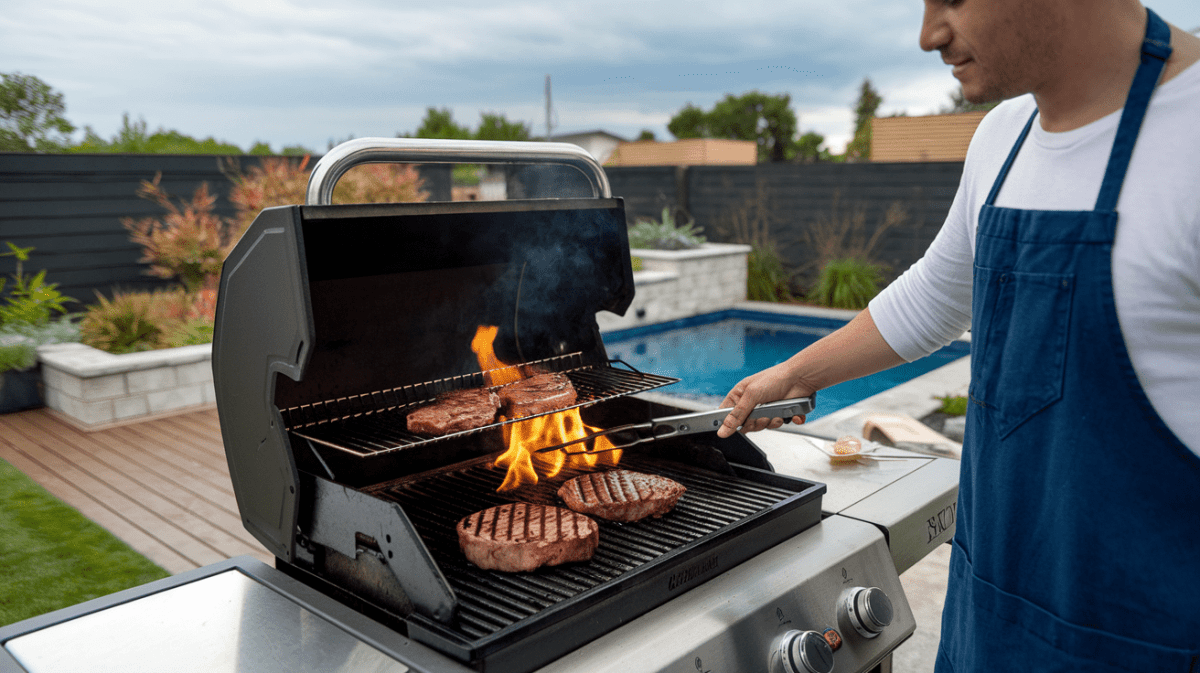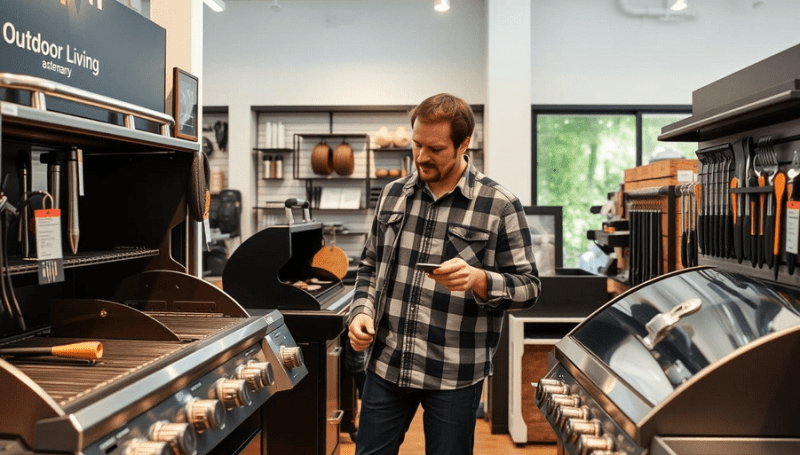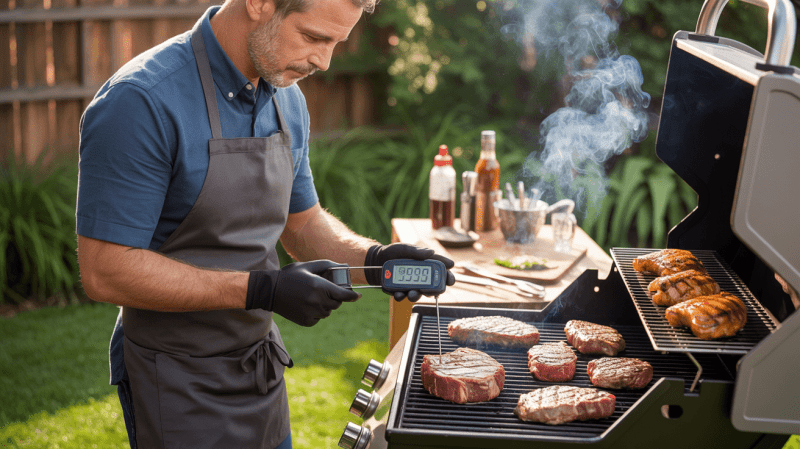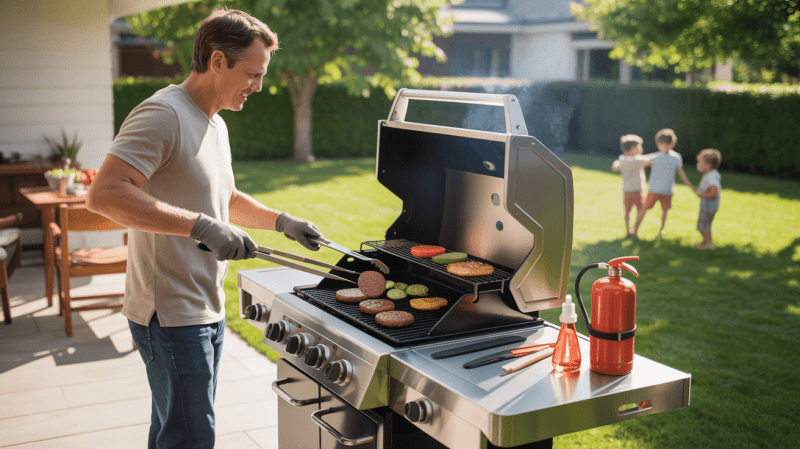Nothing says holiday celebration like a perfectly cooked prime rib. This tender, marbled cut is a showstopper at any gathering, offering rich flavor and melt-in-your-mouth texture. Whether it's Christmas Eve or a special family dinner, this dish always steals the spotlight.
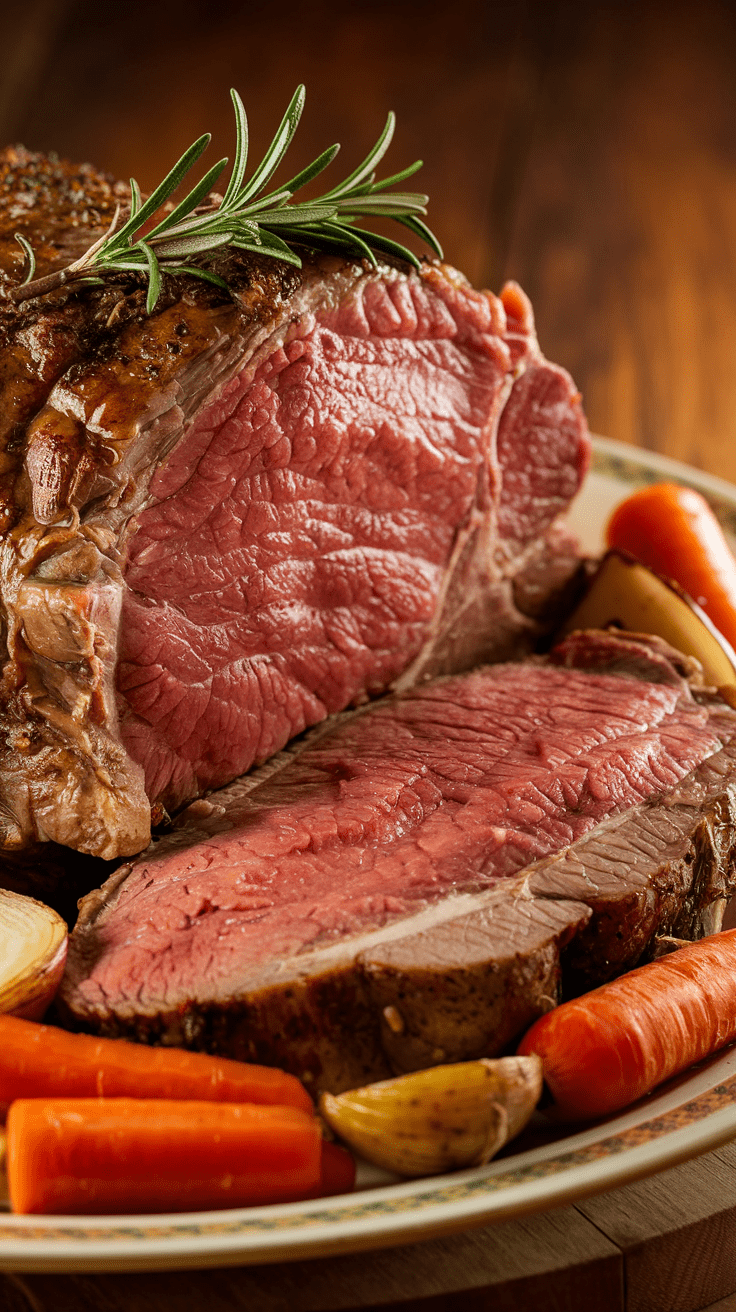
With over 30 years of experience, mastering this holiday favorite has never been easier. A Weber Genesis II gas grill with a rotisserie attachment ensures even cooking, while Home Depot’s free delivery and assembly make prep a breeze.
Selecting the right rib roast is key. Opt for a bone-in cut, properly tied by your butcher. Season generously, then slow-cook using indirect heat for juicy results. Monitoring the internal temperature guarantees perfection every time.
Key Takeaways
- Prime rib is a holiday favorite, known for its rich marbling and tenderness.
- A quality gas grill, like the Weber Genesis II, ensures consistent cooking.
- Choose a bone-in roast and have it tied securely for even heat distribution.
- Indirect heat and temperature monitoring are crucial for juicy results.
- Resting the meat before slicing locks in flavor and moisture.
Choosing the Perfect Prime Rib Roast
Quality starts with selecting the ideal roast for your gathering. The right cut meat ensures rich flavor and tender results that impress every guest.
Bone-In vs. Boneless: Which Is Better?
Bone-in prime roasts deliver superior flavor as the bones conduct heat evenly. The marrow enhances juiciness, while the ribs create a natural rack for cooking.
Boneless options work well for smaller groups and fit standard roasting pans. However, they may dry out faster without the bone's insulation.
How Much Prime Rib Per Person?
Plan for 1 pound of bone-in prime roast per adult. For boneless cuts, reduce to ¾ pound per person.
- 6-pound roast: Feeds 4-6 people
- 10-pound roast: Serves 8-12 guests
Ask Your Butcher for These Key Preparations
Always ask butcher to french the bones for elegant presentation. Request tight tying with twine to maintain shape during cooking.
Swift Meats' netting method offers an alternative to traditional tying. Discuss fat trimming preferences—leave ¼ inch for optimal browning.
Preparing Your Prime Rib for the Grill
Flavor starts long before the roast hits the grill. Proper seasoning and temperature control transform a good cut into a masterpiece. Follow these steps to ensure mouthwatering results.
Seasoning Techniques for Maximum Flavor
Two methods dominate recipes: dry rubs and wet marinades. A robust dry rub (like Hey Grill Hey Beef Rub) blends kosher salt, smoked paprika, and herbs. For richer taste, try garlic-herb butter—mix softened butter with minced garlic, rosemary, and thyme.
Enhance flavor by inserting garlic cloves into the roast. Use a paring knife to make 16 small slits in a 6-pound cut. Push a clove into each pocket for even distribution.
Why Room Temperature Matters
Letting the roast sit for 2 hours at room temperature ensures even cooking. Cold meat cooks unevenly, risking a charred exterior and raw center. Keep food safety in mind—never exceed 2 hours unrefrigerated.
- Salt’s dual role: Enhances taste and breaks down proteins for moisture retention.
- Timeline: Season 2 hours ahead, then rest at room temperature for 2 more.
- Fat cap: Leave ¼ inch for browning; trim excess to prevent flare-ups.
For deeper seasoning, dry-brine overnight. Coat the roast with salt and refrigerate uncovered. This locks in juices and intensifies the crust.
How to Grill Prime Rib Like a Pro
Proper grill setup separates good roasts from exceptional ones. Focus on heat control, timing, and tools for juicy, evenly cooked meat every time.
Setting Up Your Grill for Indirect Heat
Indirect heat prevents flare-ups and ensures even cooking. For gas grills like the Weber Genesis II, ignite burners 1 and 4 on high, leaving 2 and 3 off. This creates a 450°F zone for searing and a cooler area for slow roasting.
Charcoal users should pile coals on one side, placing a drip pan beneath the roast. Add wood chips for smoky flavor. Keep the lid closed to maintain steady grill temperature.
Rotisserie vs. Traditional Grilling
A rotisserie evenly bastes the roast in its juices, ideal for larger cuts (6–10 lbs). Cook times range from 2–3.5 hours at 325°F. For stationary grilling, flip the meat every 30 minutes to avoid hot spots.
- Rotisserie pros: Hands-off cooking, uniform crust.
- Traditional pros: No special equipment needed.
Monitoring Internal Temperature
Use a meat thermometer to track progress. Insert it into the thickest part, avoiding bones or fat. Target 125–128°F for medium rare, accounting for 8–10°F rise during resting.
| Doneness | Internal Temp (°F) | Resting Temp Rise |
|---|---|---|
| Rare | 115–120 | +10°F |
| Medium Rare | 125–128 | +8°F |
| Medium | 130–135 | +5°F |
Overcooking past medium dries out the meat. Pull the roast early—it continues cooking off the heat.
Prime Rib Cooking Times and Temperatures
Timing is everything when aiming for a perfect crust and rosy center. Balancing heat and time ensures juicy, evenly cooked meat. Whether searing first or slow-roasting, precise control elevates results.
Ideal Grill Temperature for Juicy Results
Two methods dominate: high-heat searing (450°F) for a crisp exterior or low-and-slow (275°F) for even doneness. A hybrid approach works best—sear at 450°F for 15 minutes, then reduce to 325°F.
Gas grills like the Weber Genesis II maintain steady temperature. Charcoal users should replenish coals hourly. Always use a drip pan to minimize flare-ups.
When to Pull the Roast Off the Grill
Internal temperature dictates doneness. Remove the roast at 125°F for medium-rare—it will rise to 135°F during resting. For rare, aim for 115°F; medium stops at 130°F.
| Weight (lbs) | Total Cook Time (325°F) | Internal Temp (°F) |
|---|---|---|
| 4–6 | 1–1.5 hours | 125–130 |
| 7–9 | 1.75–2.25 hours | 125–130 |
| 10+ | 2.5–3.5 hours | 125–130 |
Pro tip: Use a dual-probe thermometer to track grill and meat temperature simultaneously. Wind or cold weather may extend time by 10–15 minutes per pound.
- Carryover cooking: Meat gains 5–10°F during 30 rest minutes.
- Stall: At 150°F, evaporation slows cooking—patience is key.
- Adjustments: For thicker crusts, sear longer initially.
The Importance of Resting Your Prime Rib
The secret to a mouthwatering roast lies in what happens after it leaves the grill. Resting allows meat fibers to relax, locking in juices for maximum tenderness.
During 30 rest minutes, collagen reabsorbs moisture, while heat evenly distributes. A 6-pound roast gains 8–10°F internally, reaching the ideal 135°F for medium-rare.
Short rests (15 minutes) work for smaller cuts, but 30 minutes is golden for larger roasts. Pro tip: Use a grooved carving board to catch escaping juices for au jus.
Tenting with foil retains heat without steaming the crust. Butcher paper balances airflow and moisture for crispier edges. Both methods protect flavor during the wait.
For delayed serving, hold the roast at 120°F in a warming drawer. Reheat slices briefly in broth to preserve texture.
Carving and Serving Your Grilled Prime Rib
The final act of your culinary masterpiece begins with expert carving. Proper technique preserves tenderness and showcases your roast's perfect doneness. A sharp 9-12 inch Granton-edge knife makes clean cuts effortless.

Mastering the Slice
Remove the bones by sliding the knife along the ribs. Turn the roast upright for stable slicing. Always cut against the grain—look for muscle fiber lines and slice perpendicularly. This breaks down fibers for melt-in-your-mouth texture.
For presentation, fan slices on a platter with bones arranged as a base. Drizzle with reserved juices and garnish with rosemary sprigs. Pro tip: Warm plates prevent rapid cooling.
Flavorful Pairings
Complement rich beef with bold sauces. Classic horseradish cream blends 1 cup sour cream with 1 cup heavy cream and 3 tbsp grated horseradish. For wine lovers, reduce red wine with shallots and thyme for a glossy glaze.
- Side dishes: Yorkshire pudding soaks up juices, while roasted root vegetables add sweetness.
- Wine pairings: Cabernet Sauvignon's tannins cut through fat, while sparkling rosé refreshes the palate.
"A holiday centerpiece deserves accompaniments that enhance without overpowering."
For holiday gatherings, arrange sides in small vessels for easy passing. Creamed spinach and truffle mashed potatoes offer crowd-pleasing recipes. Remember—the roast remains the star.
Tips for Leftover Prime Rib
Leftovers don’t have to be boring—revive them with creative twists. Proper storage and reheating lock in flavor, while inventive recipes turn extra beef into new favorites.
Store leftovers in airtight containers or vacuum-sealed bags. Refrigerate for up to 4 days, or freeze portions for 3 months. Slice the cut thinly for sandwiches or cube it for hearty stews.
Reheat gently to preserve tenderness. Sous vide at 130°F restores medium-rare texture. For crispy edges, sear slices in a hot pan with butter.
- Philly cheesesteak: Sauté onions and peppers, pile on toasted rolls with melted provolone.
- Beef ramen: Add slices to broth with soft-boiled eggs and scallions.
- Broth: Simmer bones with veggies for 48 hours for rich stock.
"A great roast deserves a second act. Transform it into something unexpected."
Freeze bones and trimmings for future soups. Label packages with dates to track freshness. Thaw overnight in the refrigerator before use.
Conclusion
Mastering this holiday favorite becomes a cherished tradition with each juicy bite. Start with a quality cut from your butcher, monitor the grill temperature closely, and let the roast rest for tender, medium rare perfection.
Elevate your next gathering with smoky wood chips or a bold herb crust. For more inspiration, try the recipe from Hey Grill Hey’s smoked version.
Pro tip: Test techniques on smaller roasts before your big event. With practice, you’ll turn this centerpiece into a yearly highlight.
DISCLAIMER
This document is provided for general information purposes only and should not be relied upon as providing legal advice, technical, or specific operational guidance to the reader, whether as to the practices described in the document or the applicable legal requirements and regulations. Backyard Grilling Pros.com expressly disclaims any responsibility for liability arising from or related to the use or misuse of any information in this document.
